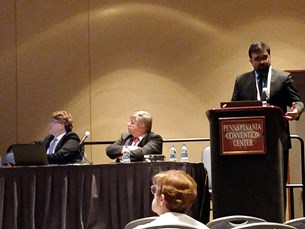Meeting
2023 ASCO Genitourinary Cancers Symposium

Mallinckrodt Institute of Radiology, Washington University School of Medicine, Saint Louis, MO
Ashwin Singh Parihar , Lisa R Schmidt , John Crandall , Farrokh Dehdashti , Barry A. Siegel , Richard L. Wahl
Background: Standardized uptake values (SUVs) on PSMA PET/CT are used as a semi-quantitative representation of in-vivo PSMA expression in prostate cancer. PSMA SUVs have been used to determine eligibility for 177Lu-PSMA therapy in previous trials, and to predict response to therapy. Higher lesion SUVmean has been shown to predict a favorable response to 177Lu-PSMA. It is known that 18F-FDG SUV is partly dependent on patient weight, and that the SUV corrected to lean-body mass (SUL) is consistent across variations in body-weight. However, the variability of PSMA SUV with body-weight is unknown. Since SUVmean on PSMA PET/CT has important diagnostic, prognostic, and therapeutic implications, we sought to assess the variability of SUVmean on 18F-DCFPyL PET/CT with body-weight in men with prostate cancer. Methods: The imaging database was searched for men with prostate cancer who underwent 18F-DCFPyL PET/CT from 2021 to 2022. We grouped the patients by age and randomly selected a maximum of 20 patients from each of the six decades of age from 40s to 90s. 18F-DCFPyL PET/CT studies were reviewed on MIM v7.1.5 workstation and semi-automatic segmentations were performed to delineate and measure the SUV of the most tracer-avid lesion. SUVs from the liver and descending thoracic aorta (blood-pool) were also measured. Additionally, the SULs were derived using the Janmahasatian formula for body mass index. A partial correlation test was performed to assess the variability of SUVmean and SULmean with body-weight. Results: A total of 85 18F-DCFPyL PET/CT studies in 85 men (mean age: 68.4±11 years; mean weight: 94.5±23.2 kg) were retrospectively analyzed. 18F-DCFPyL PET/CT was performed for evaluation of biochemical recurrence (n=56) or initial staging (n=29). At least one disease site compatible with prostate cancer was seen in 64 patients. Partial correlation tests were performed with 18F-DCFPyL dose, radiotracer uptake time and PSA value added as potential confounders for SUV. The blood-pool SUVmean (mean: 1.5±0.6; r=0.48; p<0.0001), and SUVmean of the most avid lesion (mean: 15.9±17.4; r=0.33, p=0.01) had a significant positive correlation with body weight. In contrast, liver SUVmean (mean: 5.4±1.2) was not significantly correlated with body weight (p=0.5). The SULmean of the most avid lesion (mean: 10.9±10.9; p=0.06), and blood-pool SULmean (mean: 1.0±0.3; p=0.06) did not have a significant correlation with body weight. Conclusions: Body-weight corrected SUVmean has a significant correlation with patient weight and thus is not representative of the accurate PSMA expression. As SUVmean is commonly utilized for patient selection in clinical trials and as a prognostic marker for 177Lu-PSMA therapy, these variations may lead to inaccurate outcome prediction. SULmean is a consistent representation of in-vivo PSMA expression and should be utilized for further studies of PSMA PET as a prognostic biomarker.
Disclaimer
This material on this page is ©2024 American Society of Clinical Oncology, all rights reserved. Licensing available upon request. For more information, please contact licensing@asco.org
2023 ASCO Genitourinary Cancers Symposium
Poster Session
Poster Session A: Prostate Cancer
Prostate Cancer - Advanced,Prostate Cancer - Localized
Diagnostics and Imaging
J Clin Oncol 41, 2023 (suppl 6; abstr 52)
10.1200/JCO.2023.41.6_suppl.52
52
B10
Abstract Disclosures
2023 ASCO Annual Meeting
First Author: Niclas C. Blessin
2024 ASCO Genitourinary Cancers Symposium
First Author: Keara English
2023 ASCO Annual Meeting
First Author: Ruben Raychaudhuri
2024 ASCO Genitourinary Cancers Symposium
First Author: Charlotte Hawkins